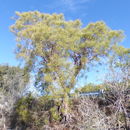More info for the terms:
fire frequency,
fire regime,
fire suppression,
forest,
frequency,
fuel,
lignotuber,
litter,
shrubsPlant Adaptations: Redshank sprouts from the lignotuber following
burning of aboveground portions of the plant [
7,
9,
16,
25,
26,
31].
Fire Ecology: Redshank communities generally have less total
aboveground biomass than chamise communities because they are more open,
but have more standing dead fuel per plant and deeper litter. A
comparison of the two species on the Los Padres National Forest showed
that redshank averaged 44 percent dead biomass versus 38 percent for
chamise [
9]. Redshank litter accumulates rapidly because of continuous
shedding of bark and abscission of stems during summer drought, and
because rate of litter decay is slow in southern California chaparral
[
17]. Redshank litter in mature stands varies from 0.5 to 2.0 inches
(1.3-5.1 cm) in depth [
15]. Litter accumulation on the Los Padres
National Forest is 1.2 tons per acre per year (1.2 t/ha/yr). Average
aboveground biomass in the 25-year-old redshank community was 12 tons
per acre (30 t/ha) [
9].
Redshank leaves are covered by a sticky resin comprising 10 to 15
percent of their dry weight. Flammable compounds found in redshank
leaves and exuded resin include flavonoids and phenolic acids. Some of
the compounds within these chemical families have been extracted from
leaves and resin and identified [
39].
Historical documents show that prior to fire suppression, southern
California chaparral usually burned in summer. Fires typically crept
down slopes by means of falling brands and coals, and only occasionally
formed the hot runs on steep slopes that are typical of today's fires.
Large fuels often smoldered for months. This fire behavior resulted in
a mosaic of numerous small burns throughout the landscape. This pattern
is still evident in northern Baja California, where fire suppression is
not practiced. In contrast, most fires in southern California now occur
in fall during Santa Ana winds and consume large patches of chaparral.
The size of individual burns increases abruptly north of the
international border. Fire suppression has reduced the number of fires,
but because of the increase in burn size, total acreage burned is
approximately the same on either side of the border [
32].
Southern California chaparral fires typically crown out, burning all or
most of the aboveground portions of shrubs [
1]. Fire frequency varies
from a few years to as long as 60, although shrubs cannot survive many
short-interval fires [
32]. Chaparral stands become extremely flammable
within 30 to 60 years after fire, depending on topography and stand
productivity [
38].
FIRE REGIMES : Find fire regime information for the plant communities in which this
species may occur by entering the species name in the
FEIS home page under
"Find FIRE REGIMES".

